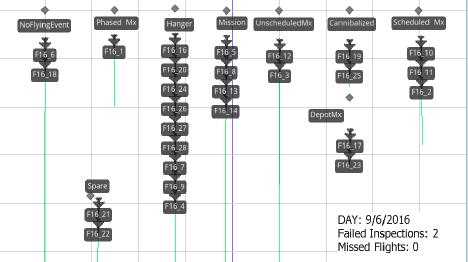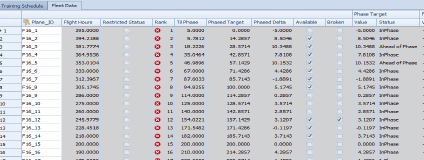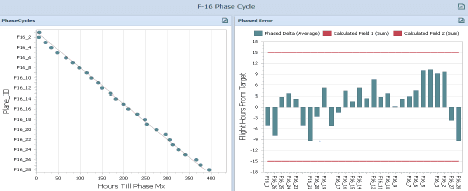by Captain Christopher Jermaine Bevelle (USAF)
As presented at the 2016 Winter Simulation Conference
In fleet management, aircraft undergo phase inspection to maximize aircraft availability. An aircraft is grounded after reaching a maximum threshold of flight hours accrued since its last phase inspection. To manage this process, planners use a time distributed index to track the phase cycle of individual aircraft and keep the planes respectively in-phase. As planes break and maintenance lines become backed-up, the avail-ability of aircraft diminish; the desired effect for the mission is lost, and the constant use of spare planes invite future scheduling hazards. In this example, planners are constantly faced with determining schedules with several random factors and risk. The model presented here via Simio is a risk-based planning and scheduling simulation to identify risk and account for randomness in phase cycles. The result of this model provides the planners the opportunity to input an actual schedule into the system, assess fleet health, and conduct what-if analysis.
Introduction
A fleet’s phase maintenance cycle is conceptually determined by dividing the restriction threshold—maxi-mum allowable flight hours accrued since last phase inspection—by the total number of aircraft in the fleet. As an example, a fleet with 20 planes and 400 hours of restriction will have an ideal of 20 hours between phase maintenance per plane as an ideal target. A time indexed distribution is commonly used as a graphical depiction to show each plane’s target time-to-phase. This concept when graphed serves as a countdown technique for a planner to determine what plane to ideally schedule next for phased maintenance and where a plane resides in its projected phase window. The graph will also overlay a scatterplot of actual flight hours accrued per plane. For the purpose of the paper, this value will be known as “phased delta” (the error from the ideal phased target for each plane).
Aircraft are scheduled for training missions (preplanned tempo), phased maintenance (1-3 weeks depending on work conditions), routine/scheduled maintenance (few hours to few days to a few weeks), depot mainte-nance (last several months), and non-flight related activities (day-to-day). Operations/deployments, un-scheduled maintenance due to ‘hard breaks’ are key events that occur randomly and infrequently. Planners may choose to “cannibalize” a plane and strip the plane of its parts to service the needs of other broken planes to avoid longer delays from ordering parts with long lead times (2-4 weeks).
Primarily the training missions account for the vast majority of flight activities. A single flying mission may last 1-3 hours, and planes are commonly scheduled in groups, and groups commonly fly consecutive flights. For example, for one day, a planner will schedule 10 planes to perform one mission, refuel, the same 10 planes complete another mission, then of those planes, 2 will stay at home station, and the remain-ing 8 will continue to perform another mission. Planes will not fly more than 5 consecutive missions. The more a plane flies in short time before going to maintenance, the more likelihood of a ‘hard break’ occur-rence. Of the planes that fly each week (usually 10-14), between 5-10 missions occur each. 2 spares per week may fly between 5-8 missions combined on average. That does not imply that 5-8 breaks occur each week.



